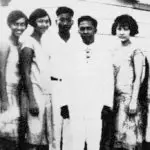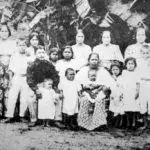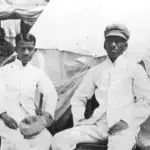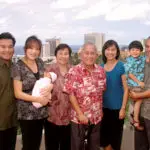Filipinos on Guam




Table of Contents
Share This
Demographics
As of 2006, Filipinos on Guam numbered 46,968 naturalized US citizens and permanent residents, as well as 1,339 temporary residents, most of them under temporary labor and investor contracts. Comprising nearly one-third of the island’s population, Filipino doctors, educators, nurses, engineers, and business people, as well as construction workers, farmers, plumbers, electricians, chefs, – are a vital part of the island’s infrastructure.
Historically, Filipinos have been on Guam from Spanish colonization in the 17th century. Besides exiling Filipino rebels, Spain brought Filipino soldiers and missionaries to the island. In the years following the Spanish American War of 1898, Americans contracted Filipino engineers and construction workers to help rebuild the island and its economy after the Second World War and several destructive typhoons.
Today, Filipinos in the medical, educational, and religious fields, continue to serve the island’s needs. Since historically many Filipinos who came to Guam decided to stay and settle on island, many CHamorus/Chamorros can claim to have a Filipino ancestor or relative.
Immigration history on Guam
Together with other Pacific islanders, Filipinos and CHamorus share indigenous cultural and linguistic and colonial histories. Thousands of years before Ferdinand Magellan accidentally landed on Guam, their common ancestors most probably lived in mainland Asia. Sailors, farmers and fishermen, they spoke a common mother tongue or related languages.
But for reasons only imagined, perhaps famine, warfare, or illness, or a combination of these reasons, they migrated south to Taiwan, the Philippines, Malaysia, Indonesia and New Guinea, and sailed east to the Mariana Islands and other islands in the Pacific Ocean. Separated by natural boundaries and time, their once common language and culture became distinct. And yet, cultural and linguistic similarities remain that point to a common Austronesian / Malayo Polynesian ancestry in spite of the absence of written records of contact and trade prior to the accidental arrival of Magellan in 1521.
Shared colonial history
Current era contact between Filipinos and CHamorus started with the advent of Western colonization. From 1668 to 1898, Spain colonized the Marianas and the Philippines.
Guam was a stopover for the annual galleon trade between Mexico and the Philippines. Manned by Filipino and Mexican sailors with a few Spanish bosses, these galleons brought not only goods for trade and other supplies, but also Filipino soldiers, missionaries, lay assistants, administrators, and even political exiles and convicts, to Guam.
When Mexico won its independence from Spain in September of 1810, the Marianas were governed and administered through the Spanish-established administrative government in the Philippines. After the Mariana’s populace was nearly decimated by warfare and disease, intermarriage with Mexicans, Filipinos, Chinese and Spaniards brought about new cultural designs while the language and ties to the ancient CHamorus were maintained.
After the defeat of Spain in the Spanish-American War of 1898, Guam and the Philippines fell under American rule. Americans continued Spain’s practice of exiling Filipinos to Guam, and started transporting Guam’s lepers to the Philippines’ Culion Island Leper Colony in 1912. From 1941 to 1944-5, Japan occupied both the Philippines and Guam. However, their shared colonial histories ended when the United States gave the Philippines commonwealth status in 1935 and independence on 4 July 1946. Guam continues to be an unincorporated territory of the US.
Spanish Era
Records of Filipinos on Guam during Spanish rule are spotty at best. It is said that when Father Diego Luís de San Vitores arrived on Guam around 1668, his lay assistant was a Filipino Cebuano named Pedro Calungsor. When San Vitores was martyred, Calungsor was killed along with him. Today, the Catholic Church has accorded both San Vitores and Calungsor “blessed” status, which is the first step towards canonization. In 1690, records show that a company of soldiers on Guam were Filipino Kapampangans.
In 1700, Governor Francisco Medrano of the Marianas proposed that thousands of CHamorus be resettled in the Philippines because the Spanish governors of the Philippines felt the Marianas was a drain on the Spanish treasury. Jesuit priests nixed this proposal.
Intermarriage made it difficult to keep separate records of Filipinos on Guam. In 1783, Spanish and Filipinos on Guam were recorded separately for the first time, with 818 Spaniards and their descendants and 648 Filipinos and their descendants. In 1819, Filipinos and their descendants reached 1,774, while the number of Spaniards decreased to 965.
The Philippines has always been a source of labor for Guam. In 1851, 65 Filipino convicts pardoned from death sentences were sent to Guam as farm laborers. After one month, they formed a conspiracy to overthrow Spanish authorities. Consequently, they were sent back to Manila. In 1861, 100 convicts were sent to the Marianas as conscript laborer-farmers who were promised money as well as a parcel of land if they were to finish serving their sentences.
The seminaries and universities that Spain established in Manila from the 17th century, as well as the relative proximity of Guam to the Philippines, made it convenient to send not only Filipino laborers to Guam, but also priests. This proximity also made it more convenient to govern Guam from the Philippines especially after Mexico won its independence from Spain. By 1817, records claim that the parish priests of Guam and Rota were sometimes Tagalogs.
American Era
In 1899, three groups of Filipinos inhabited Guam. One group was composed of political exiles sent to Guam; another group was composed of ex-convicts sent to Guam as laborers, and the third was made up of adventurous Filipinos who came to Guam as paid workers. When the Americans took over Guam and the Philippines in 1898, Jose Sisto, a Spanish-Filipino, became the acting governor/administrator for a short time.
Americans continued Spain’s practice of exiling unwanted and undesirable Filipinos to Guam and using them as conscript farm laborers. These included political prisoners and exiles who rebelled against American rule. The most famous Filipino political exile sent to Guam was the revolutionary writer/lawyer/hero and paraplegic Apolinario Mabini whom Americans labeled as insurrectionist. Exiled on Guam from 1901 to 1903, Americans allowed him to return to the Philippines only after he agreed to take the oath of allegiance to the United States. Others in his group stayed, most notably Pancrasio Palting who in 1912 became Chief Justice of the Court of Appeals.
American administrators did not keep track of Filipinos on island until 1927, when 49 Filipino convicts and political prisoners were exiled to Guam. Records show that in 1940, there were 32 Filipinos on Guam with 175 CHamoru-Filipino children. In 1930, there were 120 Filipino farmers and service personnel with a sprinkling of skilled and unskilled laborers.
The influx of a larger number of Filipinos started after the Second World War because Guam had to be rebuilt after the devastation of the war. Additionally, the military decided to make much larger bases on Guam.
Construction companies with military contracts were allowed to bring Filipino workers to the island. As construction workers, longshoremen, service workers, many of them elected to stay on island after their contracts expired. After protests from local groups as well as the decline of construction work, the influx of foreign workers was reduced.
Before the war, there were only a few hundred Filipinos on island. The Census of 1940 showed that Guam’s population of 22,290 included 90.5 percent CHamoru, 2.6 percent Filipino and 3.5 percent Caucasian. This changed after the war. By 1950, as a result of immigration and importation of Filipino labor, Filipino population increased to 7,258, or 12.2 percent of the total local population of 27,124.
In 1953, the 7,009 male Filipinos far outnumbered the island’s 249 female Filipino workers. By the mid 1950s, CHamorus felt that foreign workers had unfair advantage over them because of the foreign workers’ lower salaries. After protests from local groups, the influx of foreign workers was stemmed. Less contract workers were allowed to enter Guam. Many of those whose contracts expired were sent back to the Philippines. By 1959, the number of Filipinos decreased to 5,000. A few thousand of them became naturalized US citizens and remained on island.
The ebb and flow of Filipinos on island have been influenced by natural and man made disasters, as well as changes in US immigration laws. Particularly changes were made in 1965 which started a new system of immigration into the US and dramatically increased the numbers from Asian countries.
Besides the war, devastating typhoons have ravaged the island, leaving in their wake loss of lives and homes, as well as the destruction of the island’s infrastructure. Consequently, the need for reconstruction and rebuilding brought Filipinos and Koreans to the island after super typhoons such as Karen in 1962; Pamela in 1976; Omar in 1992; Paka in 1997; and Pongsona in 2002. By 1975, there were 10,000 people recorded as having permanent resident status on Guam. Seventy percent of these residents were Filipinos. The number of Filipinos on island has increased to nearly 50,000 today.
Notable Filipinos on Guam
It would be a monumental task to list all Filipinos who have made Guam their home and contributed in significant ways to the island’s cultural, economic and social development. It is clear that the Filipino presense in Guam is strong and multifaceted.
The number of civic and ethnic organizations within the structure of the umbrella Filipino Community of Guam numbers over seventy. They make their contributions to island life while they continue to be of some assistance to the places they left behind in the Philippines. The technical fields, the construction trades, the professions and the rhythm of social life on Guam has been strengthened by the contributions of Filipinos who have settled on Guam and made their mark.
Ties between the island and the Philippines remain strong. Filipino priests continue to serve in Guam’s parishes. Skilled contract workers continue to come as the military continues to beef up its bases. Due to the island’s proximity to the Philippines, many Filipinos like living and working on Guam and elect to stay.
For further reading
Achútegui, Pedro S. de, and Miguel Bernad. Religious Revolution in the Philippines: The Life and Church of Gregorio Aglipay, 1860-1960. Vol. 2. Manila: Ateneo de Manila, 1960.
Alkire, William H. An Introduction to the Peoples and Cultures of Micronesia. 2nd ed. Menlo Park: Cummings Publishing Co., 1977.
Campbell, Bruce L. “The Filipino Community of Guam (1945-1975).” MA thesis, University of Hawai’i, 1987.
Fritz, Georg. The Chamorro: A History and Ethnography of the Mariana Islands. 2nd ed. Translated by Elfriede Craddock and edited by Scott Russell. Occasional Historical Papers Series, No. 1. Saipan: Commonwealth of the Northern Mariana Islands Division of Historic Preservation, 2001.
Hezel, Francis X., SJ. From Conquest to Colonization: Spain in the Marianas 1690-1740. Saipan: Commonwealth of the Northern Mariana Islands Division of Historic Preservation, 1989.
Ibañez y Garcia, Luis de. The History of the Marianas, with Navigational Data, and of the Caroline and Palau Islands: From the Time of their Discovery by Magellan in 1521 to the Present. Translated and annotated by Marjorie G. Driver. MARC Educational Series no. 12. Mangilao: Micronesian Area Research Center, University of Guam, 1992.
Johnston, Emilie G., ed. Father San Vitores: His Life, Times, and Martyrdom. MARC Publications Series 6. Mangilao: Micronesian Area Research Center, University of Guam, 1979.
Jorgensen, Marilyn Anne. “Expressive Manifestations of Santa Marian Camalin as Key Symbol in Guamanian Culture.” PhD diss., University of Texas at Austin, 1984.
Mayo, Larry W. “Occupations and Chamorro Social Status: A Study of Urbanization in Guam.” PhD diss., University of California-Berkeley, 1984.
Risco, Alberto, SJ. The Apostle of the Marianas: The Life, Labors, and Martyrdom of Ven. Diego Luis de San Vitores, 1627-1672. Translated by Juan M.H. Ledesma, SJ and edited by Msgr. Oscar L. Calvo. Hagåtña: Diocese of Agana, 1970.
Thompson, Laura M. Guam and Its People. With a Village Journal by Jesus C. Barcinas. 3rd ed. New Jersey: Princeton University Press, 1947.
